The Late Glacial Advance of the James Lobe, South Dakota, Suggests Climate-Driven Laurentide Ice Sheet Behavior
Abstract
1. Introduction
2. Methods
2.1. Regional Setting
2.2. Stratigraphic Analysis
2.3. Acquisition and Reduction of Radiocarbon Ages
- ○
- The original source or citation was available for every sample number, and the radiocarbon age could be verified.
- ○
- Each sample had location data (i.e., latitude, longitude, depth).
- ○
- Each sample was from organic material that was in place and showed minimal signs of transport (i.e., glaciotectonic disturbance).
2.4. Analysis of Radiocarbon Ages
3. Results
3.1. Stratigraphy of the James Basin
3.2. Radiocarbon Chronology
4. Discussion
Comparing the Timing of Glacial Advance Across the Southern Laurentide Margin
5. Conclusions
Author Contributions
Funding
Data Availability Statement
Conflicts of Interest
References
- Clayton, L.; Moran, S.R. Chronology of Late Wisconsinan Glaciation in Middle North America. Quat. Sci. Rev. 1982, 1, 55–82. [Google Scholar] [CrossRef]
- Hallberg, G.R.; Kemmis, T.J. Stratigraphy and Correlation of the Glacial Deposits of the Des Moines and James Lobes and Adjacent Areas in North Dakota, South Dakota, Minnesota, and Iowa. Quat. Sci. Rev. 1986, 5, 65–68. [Google Scholar] [CrossRef]
- Mickelson, D.M.; Colgan, P.M. The southern Laurentide Ice Sheet. Dev. Quat. Sci. 2003, 1, 1–16. [Google Scholar]
- Margold, M.; Stokes, C.R.; Clark, C.D. Reconciling records of ice streaming and ice margin retreat to produce a paleogeographic reconstruction of the deglaciation of the Laurentide Ice Sheet. Quat. Sci. Rev. 2018, 189, 1–30. [Google Scholar] [CrossRef]
- Denton, G.H.; Hughes, T. The Last Great Ice Sheets; John Wiley and Sons: New York, NY, USA, 1981. [Google Scholar]
- Dyke, A.S.; Prest, V.K. Paleogeography of Northern North America, 18000–5000 Years Ago; Map No. 1703A, scale 1:12,500,00; Geological Survey of Canada: Ottawa, ON, Canada, 1987. [Google Scholar]
- Hansel, A.K.; Johnson, W.H. Wedron and Mason Groups: Lithostratigraphic Reclassification of Deposit of the Wisconsin Episode, Lake Michigan Lobe Area; Bulletin No. 104; Illinois State Geological Survey: Champaign, IL, USA, 1986. [Google Scholar]
- Lowell, T.V.; Hayward, R.K.; Denton, G.H. Role of Climate Oscillations in Determining Ice-Margin Position: Hypothesis, Examples, and Implications. Geol. Surv. Am. Spec. Pap. 1999, 337, 193–203. [Google Scholar]
- Balco, G.; Schaefer, J. Cosmogenic-nuclide and Varve Chronologies for the Deglaciation of Southern New England. Quat. Geochronol. 2006, 1, 15–28. [Google Scholar] [CrossRef]
- Curry, B.B. Surficial Geology of Hampshire Quadrangle; Illinois Geologic Quadrangle Map IGQ Hampshire-SG; Illinois State Geological Survey: Champaign, IL, USA, 2008. [Google Scholar]
- Heath, S.L.; Loope, H.M.; Curry, B.B.; Lowell, T.V. Pattern of Southern Laurentide Ice Sheet Margin Position Changes During Heinrich Stadials 2 and 1. Quat. Sci. Rev. 2018, 201, 362–379. [Google Scholar] [CrossRef]
- Heath, S.L.; Lowell, T.V.; Hall, B.L. Surface Exposure Dating of the Pierre Sublobe of the James Lobe, Laurentide Ice Sheet. Quat. Res. 2020, 97, 88–98. [Google Scholar] [CrossRef]
- Benn, D.W.; Bettis III, E.A. Archaeological & Geomorphological Survey of the Downstream Corridor, Saylorville Lake, Iowa; Report of Investigations No. 109; Luther College Archaeological Research Center: Decorah, IA, USA, 1981. [Google Scholar]
- Bettis, E.A.; Hoyer, B.E. Late Wisconsin and Holocene Landscape Evolution and Alluvial Stratigraphy in the Saylorville Lake Area, Central Des Moines River Valley, Iowa; Open File Report No. 86-1; Iowa Geological Survey: Iowa City, IA, USA, 1986. [Google Scholar]
- Lundstrom, S.; Paces, J.; Iles, D.; Cowman, T. Nature and Timing of the Latest Wisconsin Advance of the James River Lobe, South Dakota. Available online: https://www.researchgate.net/publication/252728989_Nature_and_timing_of_the_latest_Wisconsin_advance_of_the_James_River_lobe_South_Dakota (accessed on 20 June 2025).
- Iverson, N.R.; Krueger, S.E.; Harding, C. Absent Drumlins Beneath Southern Lobes of the Laurentide Ice Sheet: A New Hypothesis Based on Des Moines Lobe Dynamics Inferred from Landforms. Earth Surf. Process. Landf. 2023, 48, 3181–3198. [Google Scholar] [CrossRef]
- Clayton, L.; Teller, J.T.; Attig, J.W. Surging of the Southwestern Part of the Laurentide Ice Sheet. Boreas 1985, 14, 235–241. [Google Scholar] [CrossRef]
- Patterson, C.J. Southern Laurentide Ice Lobes were Created by Ice Streams: Des Moines Lobe in Minnesota, USA. Sediment. Geol. 1997, 111, 249–261. [Google Scholar] [CrossRef]
- Patterson, C.J. Laurentide Glacial Landscapes: The role of Ice Streams. Geology 1998, 7, 643–646. [Google Scholar] [CrossRef]
- Jennings, C.E. Terrestrial ice streams—A view from the lobe. Geomorphology 2006, 75, 100–124. [Google Scholar] [CrossRef]
- Flint, R.F. Pleistocene Geology of Eastern South Dakota; Professional Paper No. 262; U.S. Geological Survey: Denver, CO, USA, 1955.
- Christensen, C.M.; Stephens, J.C. Geology and Hydrology of Clay County South Dakota; Bulletin No. 19; South Dakota Geological Survey: Vermillion, SD, USA, 1967.
- Christensen, C.M. Geology and Water Resources of Bon Homme County, South Dakota, Part I: Geology; Bulletin No. 21; South Dakota Geological Survey: Vermillion, SD, USA, 1974.
- McCormick, K.A.; Hammond, R.H. Geology of Lincoln and Union Counties, South Dakota; Bulletin No. 39; South Dakota Geological Survey: Vermillion, SD, USA, 2004.
- Johnson, G.D.; McCormick, K.A. Geology of Yankton County, South Dakota; Bulletin No. 34; South Dakota Geological Survey Bulletin: Vermillion, SD, USA, 2005.
- Steece, F.V.; Howells, L.W. Geology and Ground Water Supplies in Sanborn County South Dakota; Bulletin No. 17; South Dakota Geological Survey: Vermillion, SD, USA, 1965.
- Hedges, L.S. Geology and Water Resources of Beadle County South Dakota Part I: Geology; Bulletin No. 18; South Dakota Geological Survey: Vermillion, SD, USA, 1968.
- Jorgenson, D.G. Geology and Water Resources of Bon Homme County South Dakota, Part II: Water Resources; Bulletin No. 21; South Dakota Geological Survey: Vermillion, SD, USA, 1971.
- Koch, N.C. Geology and Water Resources of Marshall County, South Dakota; Bulletin No. 23; South Dakota Geological Survey: Vermillion, SD, USA, 1975.
- Christensen, C.M. Geology and Water Resources of McPherson, Edmunds and Faulk Counties, South Dakota, Part I: Geology; Bulletin No. 26; South Dakota Geological Survey: Vermillion, SD, USA, 1977.
- Leap, D.I. Geology and Water Resources of Brown County, South Dakota, Part I: Geology; Bulletin No. 25; South Dakota Geological Survey: Vermillion, SD, USA, 1986.
- Christensen, C.M. Geology and Water Resources of Clark Couty, South Dakota, Part I: Geology; Bulletin No. 29; South Dakota Geological Survey: Vermillion, SD, USA, 1987.
- Helgerson, R.; Duchossois, G.E. Geology and Water Resources of Hand and Hyde Counties, South Dakota, Part I: Geology; Bulletin No. 28; South Dakota Geological Survey: Vermillion, SD, USA, 1987.
- Schroeder, W. Geology and Water Resources of Miner County, South Dakota, Part I: Geology; Bulletin No. 31; South Dakota Geological Survey: Vermillion, SD, USA, 1988.
- Christensen, C.M. Geology of Davison and Hanson Counties, South Dakota; Bulletin No. 33; South Dakota Geological Survey: Vermillion, SD, USA, 1989.
- Tomhave, D.W. Geology of Spink County, South Dakota; Bulletin No. 38; South Dakota Geological Survey: Vermillion, SD, USA, 1997.
- Hedges, L.S. Geology of Aurora and Jerauld Counties, South Dakota; Bulletin No. 32; South Dakota Geological Survey: Vermillion, SD, USA, 2001.
- Schulz, L.D.; Jarret, M.J. Geology of Brookings and Kingsbury Counties, South Dakota; Bulletin No. 40; South Dakota Geological Survey: Vermillion, SD, USA, 2009.
- Reimer, P.J.; Austin, W.E.N.; Bard, E.; Bayliss, A.; Blackwell, P.G.; Bronk Ramsey, C.; Butzin, M.; Cheng, H.; Edwards, R.L.; Friedrich, M.; et al. The IntCal20 Northern Hemisphere Radiocarbon Age Calibration Curve (0-55 kBP). Radiocarbon 2020, 62, 725–757. [Google Scholar] [CrossRef]
- Lougheed, B.C.; Obrochta, S.P. MatCal: Open-source Bayesian 14C age Calibration in Matlab. J. Open Res. Softw. 2016, 4, e42. [Google Scholar] [CrossRef]
- Ives, P.C.; Levin, B.; Oman, C.L.; Rubin, M. U.S. Geological Survey Radiocarbon Dates IX. Radiocarbon 1967, 9, 505–529. [Google Scholar] [CrossRef]
- Steece, F.V. Late Wisconsin Ice-Perched Lake Deposit, Lincoln County, South Dakota. Proc. S. D. Acad. Sci. 1966, 45, 67–73. [Google Scholar]
- Ives, P.C.; Levin, B.; Robinson, R.D.; Rubin, M. U.S. Geological Survey Radiocarbon Dates VII. Radiocarbon 1964, 6, 37–76. [Google Scholar] [CrossRef]
- Barnosky, C.W.; Grimm, E.C.; Wright, H.E., Jr. Towards a Postglacial History of the Northern Great Plains: A Review of the Paleoecologic Problems. Ann. Carnegie Mus. 1987, 56, 259–273. [Google Scholar] [CrossRef]
- Bender, M.M.; Baerreis, D.A.; Bryson, R.A.; Steventon, R.L. University of Wisconsin Radiocarbon Dates XIX. Radiocarbon 1982, 1, 83–100. [Google Scholar] [CrossRef]
- Sullivan, B.M.; Spiker, E.; Rubin, M. U.S. Geological Survey Radiocarbon Dates XI. Radiocarbon 1970, 12, 319–334. [Google Scholar] [CrossRef]
- Dean, W.E.; Schwalb, A. Holocene Environmental and Climatic Change in the Northern Great Plains as Recorded in the Geochemistry of Sediments in Pickerel Lake, South Dakota. Quat. Int. 2000, 67, 5–20. [Google Scholar] [CrossRef]
- Watts, W.A.; Bright, R.C. Pollen, Seed and Mollusk Analysis of a Sediment Core from Pickerel Lake, Northeastern South Dakota. Geol. Soc. Am. Bull. 1968, 79, 855–876. [Google Scholar] [CrossRef]
- Lithologic Logs: 094N56W18CCCB. Available online: https://gis.usd.edu/lithlogs/YANKTON/094N56W18CCCB.pdf (accessed on 22 June 2025).
- Deevey, E.S.; Gralenski, L.J.; Hoffren, V. Yale Natural Radiocarbon Measurements IV. Radiocarbon 1959, 1, 144–172. [Google Scholar] [CrossRef][Green Version]
- Barendsen, G.W.; Deevey, E.S.; Gralenski, L.J. Yale Natural Radiocarbon Measurements III. Science 1957, 126, 908–919. [Google Scholar] [CrossRef]
- Lithologic Logs: 096N56W36DDCD. Available online: https://gis.usd.edu/lithlogs/YANKTON/096N56W36DDCD.pdf (accessed on 22 June 2025).
- Rubin, M.; Alexander, C. U.S. Geological Survey Radiocarbon Dates V. Radiocarbon 1960, 2, 129–185. [Google Scholar] [CrossRef]
- Stuiver, M. Yale Natural Radiocarbon Measurements IX. Radiocarbon 1969, 11, 545–658. [Google Scholar] [CrossRef]
- Levin, B.; Ives, P.C.; Oman, C.L.; Rubin, M. U.S. Geological Survey Radiocarbon Dates VIII. Radiocarbon 1965, 7, 372–398. [Google Scholar] [CrossRef]
- Biessel, D.R.; Gilbertson, J.P. Geology and Water Resources of Deuel and Hamlin Counties, South Dakota, Part 1: Geology; Bulletin No. 27; South Dakota Geological Survey: Vermillion, SD, USA, 1987.
- Martin, J.E.; Klukas, R.W. New Locality for Late Pleistocene Fossils from Edmunds County, South Dakota. Proc. S.D. Acad. Sci. 1989, 68, 57–58. [Google Scholar]
- Lowell, T.V. The Application of Radiocarbon Age Estimates to the Dating of Glacial Sequences: An Example from the Miami Sublobe, Ohio, USA. Quat. Sci. Rev. 1995, 14, 85–99. [Google Scholar] [CrossRef]
- Kelly, M.A.; Lowell, T.V.; Applegate, P.J.; Phillips, F.M.; Schaefer, J.M.; Smith, C.A.; Kim, H.; Leonard, K.C.; Hudson, A.M. A Locally Calibrated Late Glacial 10Be Production Rate from a Low-Latitude, High-Altitude Site in the Peruvian Andes. Quat. Geochronol. 2015, 26, 70–85. [Google Scholar] [CrossRef]
- Kopczynski, S.E.; Kelley, S.E.; Lowell, T.V.; Evenson, E.B.; Applegate, P.J. Latest Pleistocene advance and collapse of the Matanuska—Knik glacier system, Anchorage Lowland, southern Alaska. Quat. Sci. Rev. 2017, 156, 121–134. [Google Scholar] [CrossRef]
- Kozlowski, A.L.; Bird, B.C.; Lowell, T.V.; Smith, C.A.; Feranec, R.S.; Graham, B.L. Minimum Age of the Mapleton, Tully, and Labrador Hollow Moraines Indicates Correlation with the Port Huron Phase in Central New York State. In Quaternary Glaciation of the Great Lakes Region: Process, Landforms, Sediments, and Chronology; Kehew, A.E., Curry, B.B., Eds.; The Geological Society of America: McLean, VA, USA, 2018; Volume 530. [Google Scholar]
- Tomhave, D.W.; Schulz, L.D. Bedrock Geologic Map Showing Configuration of the Bedrock Surface in South Dakota East of the Missouri River; General Map No. G-09; South Dakota Geological Survey: Vermillion, SD, USA, 2004.
- Kerr, P.J.; Tassier-Surine, S.A.; Kilgore, S.M.; Bettis, E.A.; Dorale, J.A.; Cramer, B.D. Timing, Provenance, and Implications of Two MIS 3 Advances of the Laurentide Ice Sheet into the Upper Mississippi River Basin, USA. Quat. Sci. Rev. 2021, 261, 106296. [Google Scholar] [CrossRef]
- Broecker, W.S.; Farrand, W.R. Radiocarbon Age of the Two Creeks Forest Bed, Wisconsin. Geol. Soc. Am. Bull. 1963, 74, 795–802. [Google Scholar] [CrossRef]
- Leavitt, S.W. A New Tree-Ring δ13C and 14C Investigation of the Two Creeks Site. Radiocarbon 1992, 34, 792–797. [Google Scholar] [CrossRef]
- Kaiser, K.F. Two Creeks Interstade Dated through Dendrochronology and AMS. Quat. Res. 1994, 42, 288–298. [Google Scholar] [CrossRef]
- Rech, J.A.; Nekola, J.C.; Pigati, J.S. Radiocarbon ages of terrestrial gastropods extend duration of ice-free conditions at the Two Creeks bed, Wisconsin, USA. Quat. Res. 2012, 77, 289–292. [Google Scholar] [CrossRef]
- Larson, G.J.; Lowell, T.V.; Ostorm, N.E. Evidence for the Two Creeks interstade in the Lake Huron basin. Can. J. Earth Sci. 1994, 31, 793–797. [Google Scholar] [CrossRef]
- Young, R.A.; Gordon, L.M.; Owen, L.A.; Huot, S.; Zerfas, T.D. Evidence for a late glacial advance near the beginning of the Younger Dryas in western New York State: An event postdating the record for local Laurentide ice sheet recession. Geosphere 2020, 17, 271–305. [Google Scholar] [CrossRef]
- Putnam, A.E.; Denton, G.H.; Schaefer, J.M. A 10Be Chronology of the Esmark Moraine and Lysefjorden Region, Southwestern Norway: Evidence for Coeval Glacier Resurgence in Both Polar Hemispheres During the Antarctic Cold Reversal. Quat. Sci. Rev. 2023, 316, 108259. [Google Scholar] [CrossRef]
- WAIS Divide Project Members. Precise Interpolar Phasing of Abrupt Climate Change During the Last Ice Age. Nature 2015, 520, 661–665. [Google Scholar] [CrossRef]
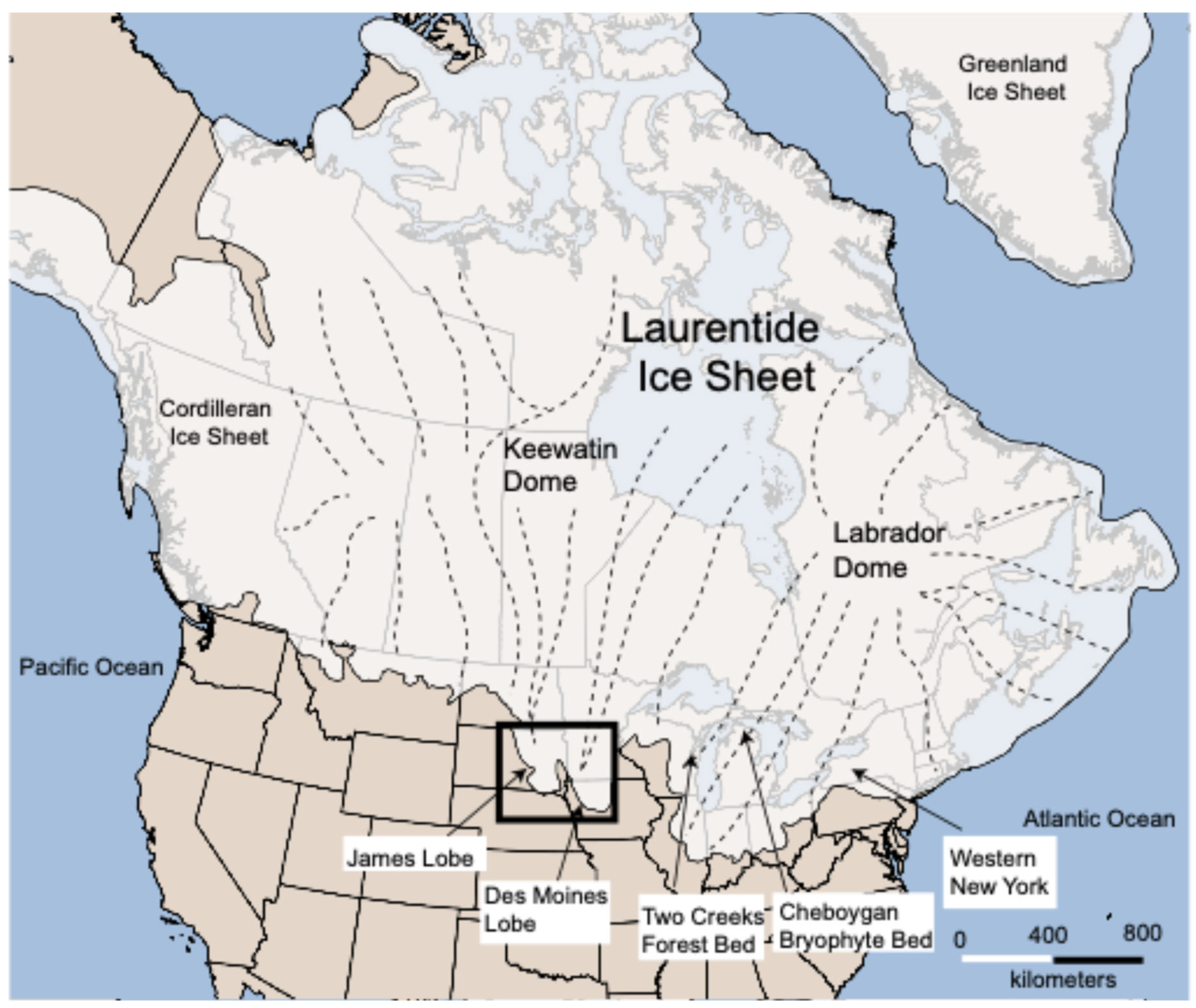
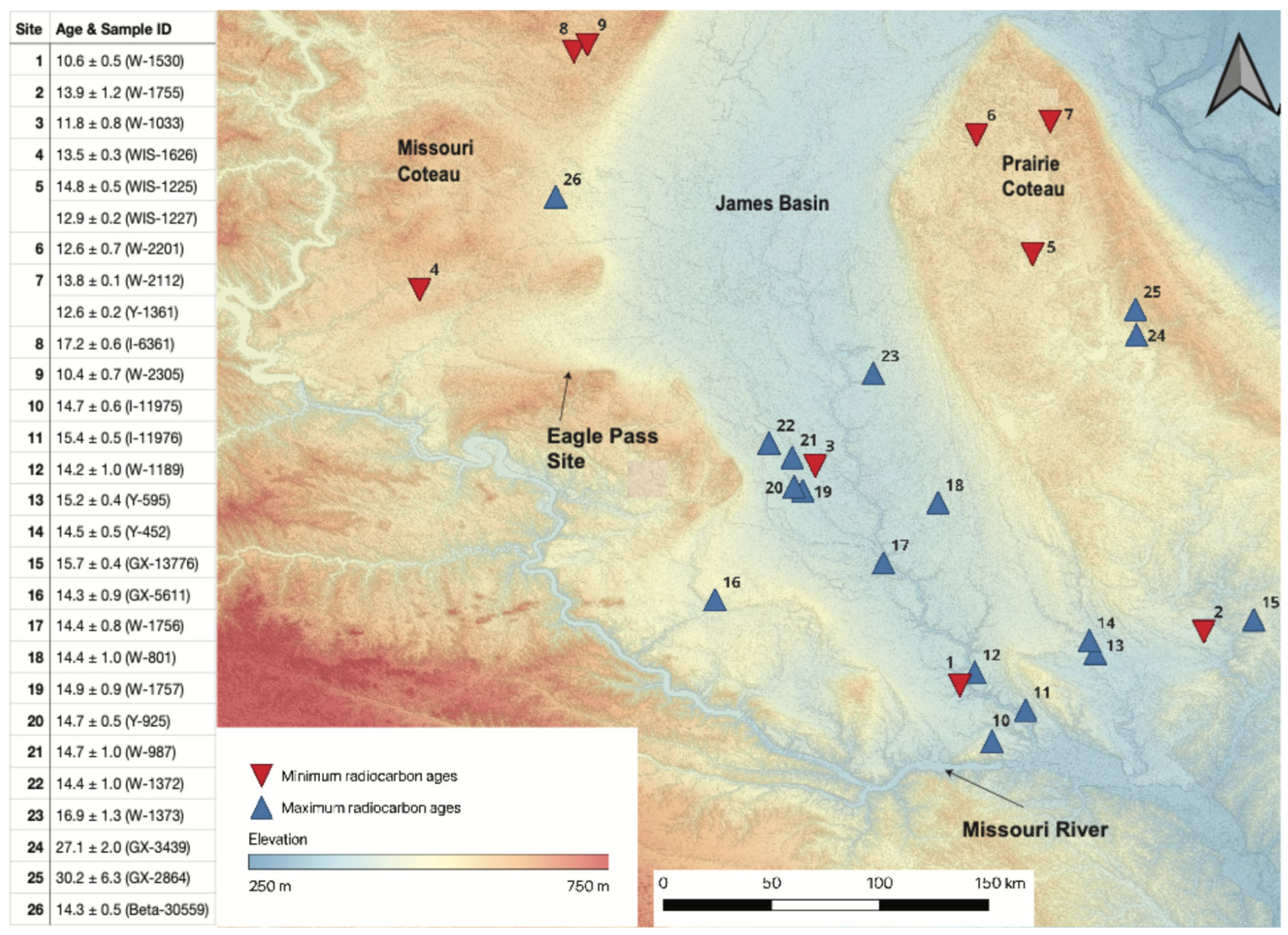
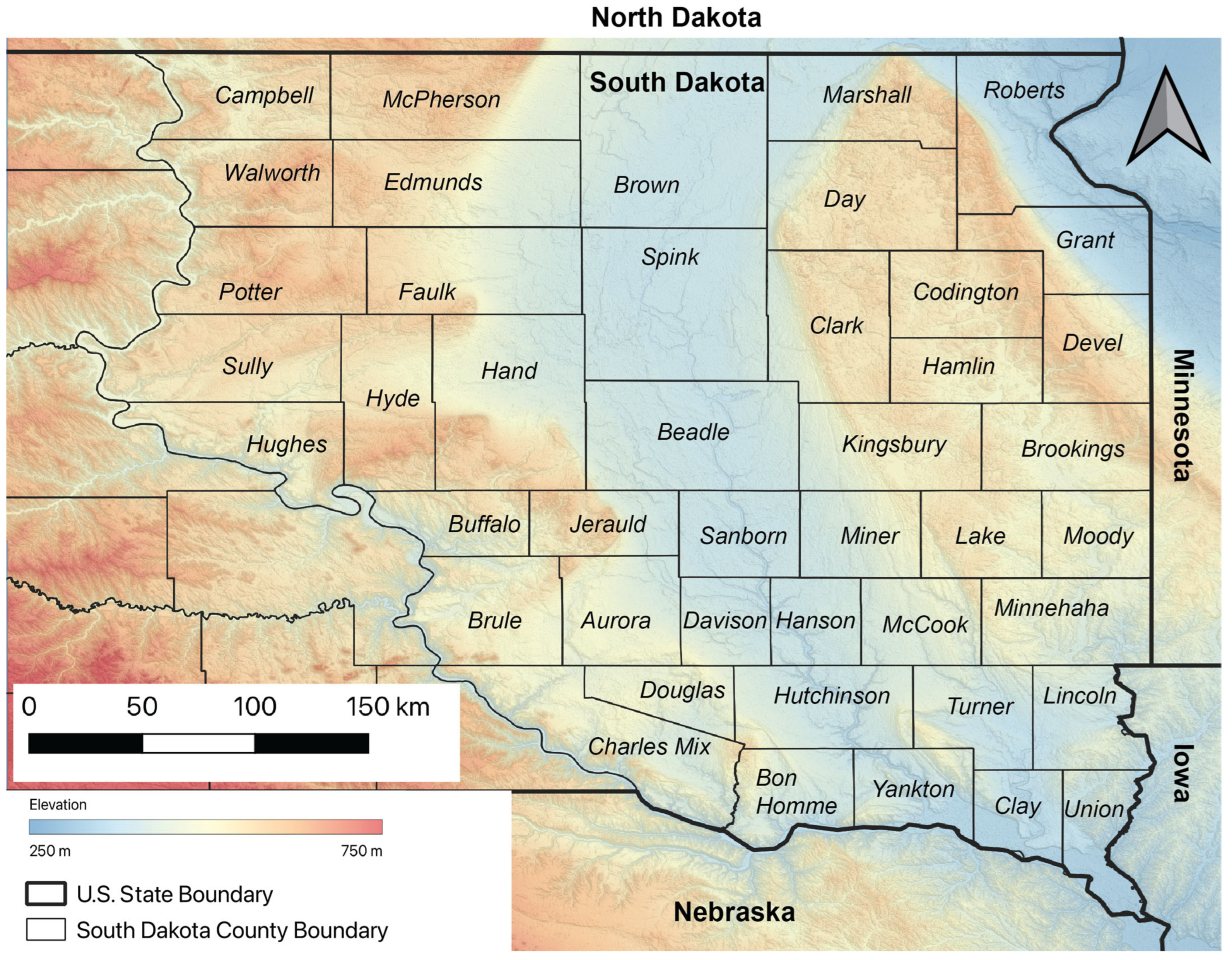
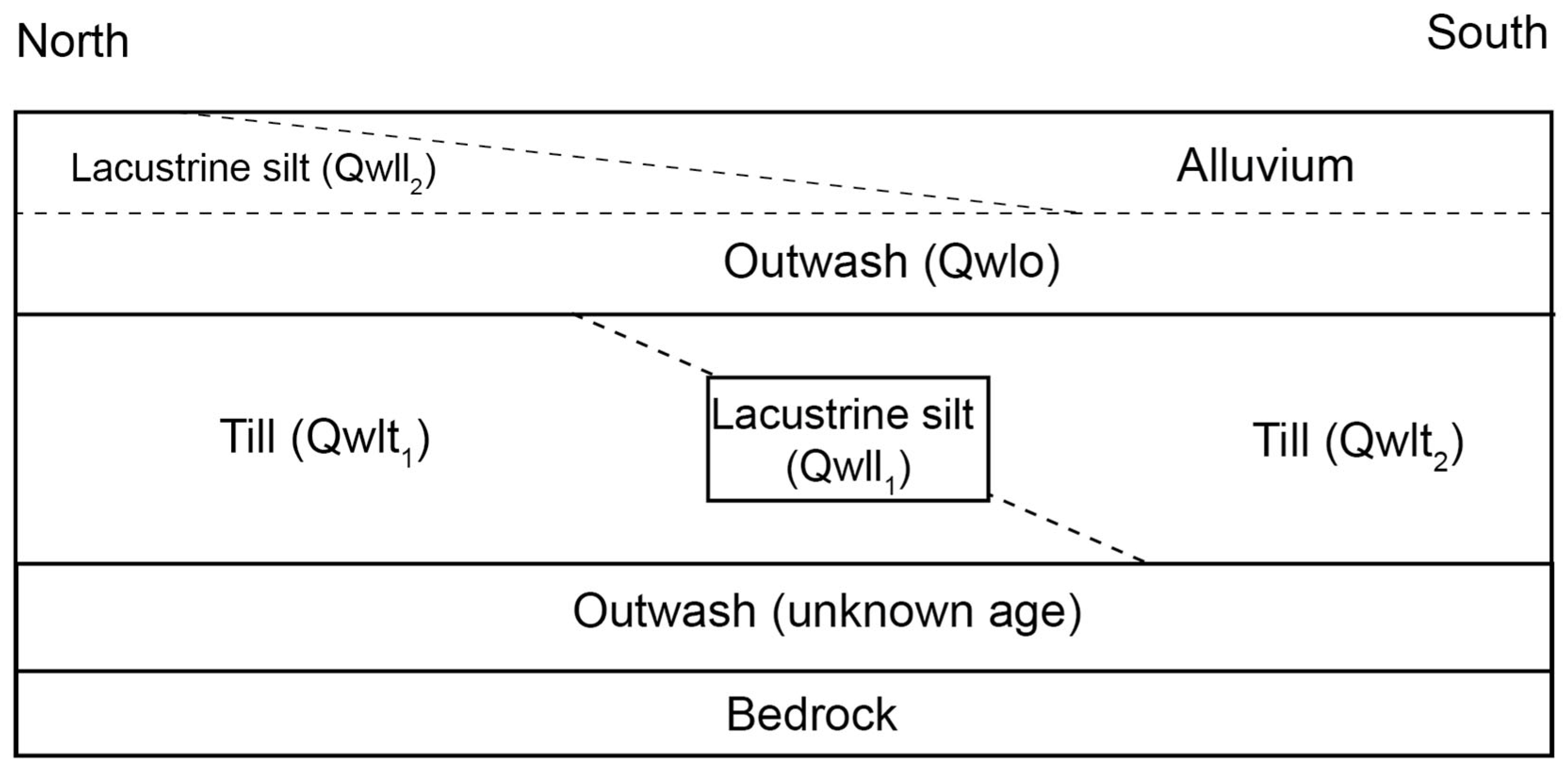
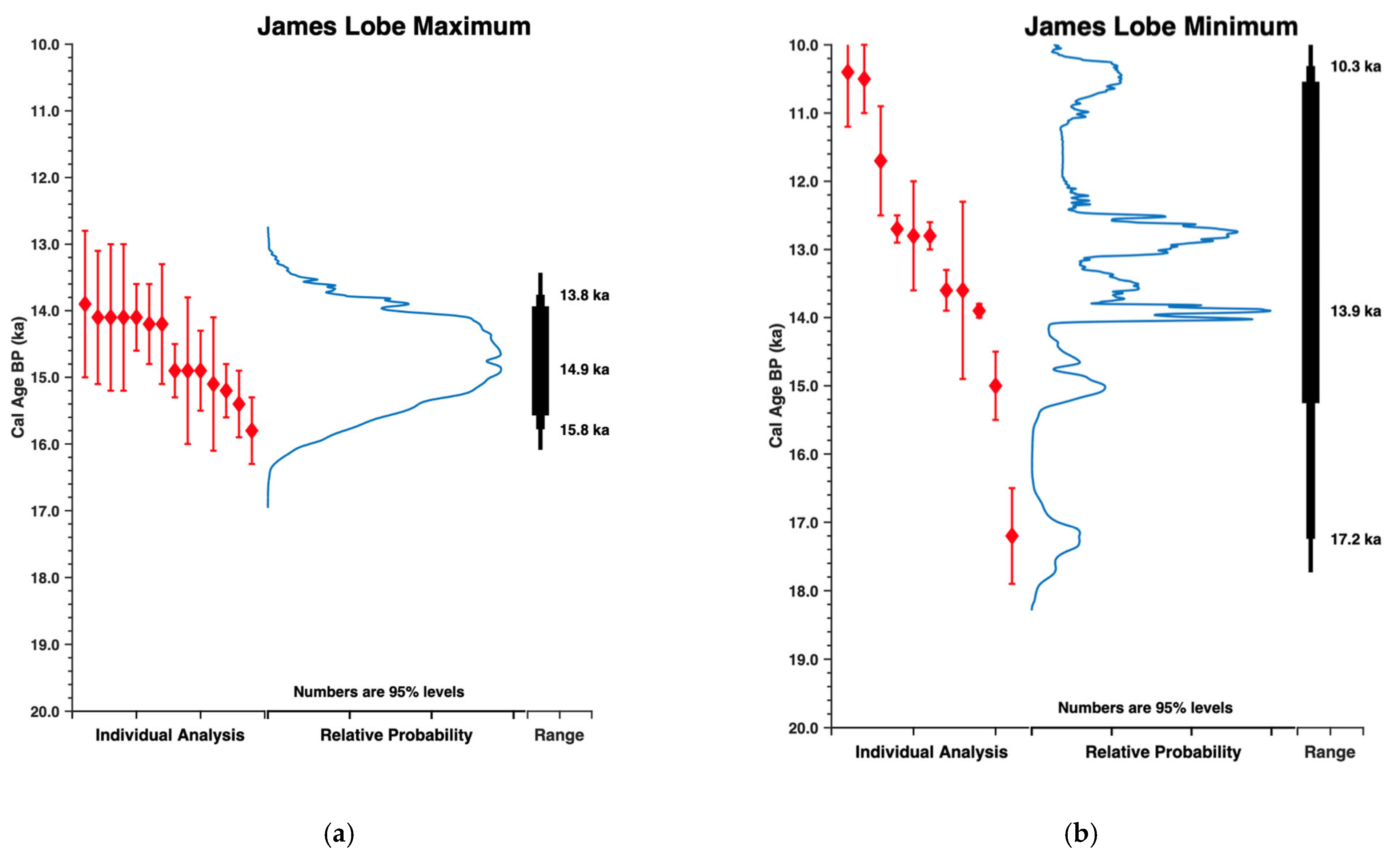

| Site ID | Sample ID | Latitude | Longitude | Material | 14C Age | Age, ka (95.4% Probability) | Stratigraphic Context | Ref. |
|---|---|---|---|---|---|---|---|---|
| 1 | W-1530 | 43.186 | −97.658 | Wood | 9300 ± 200 | 10,121–11,182 | Min. age—James Basin | [41] |
| 2 | W-1755 | 43.408 | −96.646 | Lymnaea shells | 11,770 ± 500 | 12,737–15,237 | Min. age—James Basin | [42] |
| 3 | W-1033 | 44.099 | −98.258 | Shells | 10,060 ± 300 | 10,992–12,623 | Min. age—James Basin | [43] |
| 4 | WIS-1626 | 44.833 | −99.9 | Picea needles | 11,690 ± 180 | 13,229–13,872 | Min. age—Missouri Cot. | [44] |
| 5 | WIS-1225 | 44.981 | −97.357 | Gyttia | 12,610 ± 120 | 14,312–15,326 | Min. age—Prairie Cot. | [45] |
| 5 | WIS-1227 | 44.981 | −97.357 | Wood | 10,940 ± 140 | 12,701–13,115 | Min. age—Prairie Cot. | [45] |
| 6 | W-2201 | 45.477 | −97.589 | Pelecypod shells | 10,880 ± 320 | 11,878–13,447 | Min. age—Prairie Cot. | [46] |
| 7 | W-2112 | 45.533 | −97.283 | Wood | 12,070 ± 40 | 13,808–13,962 | Min. age—Prairie Cot. | [47] |
| 7 | Y-1361 | 45.533 | −97.283 | Picea wood | 10,670 ± 140 | 12,419–12,900 | Min. age—Prairie Cot. | [48] |
| 8 | I-6361 | 45.824 | −99.26 | Organic material | 14,190 ± 220 | 16,607–17,938 | Min. age—Missouri Cot. | [30] |
| 9 | W-2305 | 45.853 | −99.204 | Pelecypod shells | 9220 ± 300 | 96,656–11,195 | Min. age—Missouri Cot. | [30] |
| 10 | I-11975 | 42.954 | −97.525 | Wood | 12,540 ± 170 | 14,105–15,313 | Max. age—Qwlt2 | [49] |
| 11 | I-11976 | 43.083 | −97.385 | Wood | 12,880 ± 170 | 14,864–15,947 | Max. age—Qwlt2 | [25] |
| 12 | W-1189 | 43.24 | −97.596 | Wood | 12,050 ± 400 | 13,167–15,284 | Max. age—Qwlt2 | [43] |
| 13 | Y-595 | 43.321 | −97.097 | Picea wood | 12,760 ± 120 | 14,837–15,636 | Max. age—Qwlt2 | [50] |
| 14 | Y-452 | 43.373 | −97.121 | Spruce wood | 12,330 ± 180 | 13,985–15,089 | Max. age—Qwlt2 | [51] |
| 15 | GX-13776 | 43.459 | −96.439 | Wood | 13,150 ± 160 | 15,317–16,211 | Max. age—Qwlt2 | [52] |
| 16 | GX-5611 | 43.543 | −98.674 | Wood | 12,180 ± 360 | 13,342–15,337 | Max. age—Qwlt2 | [37] |
| 17 | W-1756 | 43.696 | −97.975 | Wood | 12,340 ± 300 | 13,602–15,389 | Max. age—Qwlt2 | [41] |
| 18 | W-801 | 43.946 | −97.749 | Wood | 12,200 ± 400 | 13,320–15,502 | Max. age—Qwlt2 | [53] |
| 19 | W-1757 | 43.996 | −98.31 | Wood | 12,680 ± 300 | 14,038–15,932 | Max. age—Qwlt2 | [41] |
| 20 | Y-925 | 44.014 | −98.346 | Wood | 12,520 ± 100 | 14,272–15,158 | Max. age—Qwlt2 | [54] |
| 21 | W-987 | 44.135 | −98.354 | Wood fragments | 12,530 ± 350 | 13,758–15,833 | Max. age—Qwlt2 | [43] |
| 22 | W-1372 | 44.195 | −98.451 | Wood | 12,200 ± 400 | 13,320–15,502 | Max. age—Qwlt2 | [55] |
| 23 | W-1373 | 44.484 | −98.018 | Pelecypod shells | 14,000 ± 500 | 15,601–18,253 | Max. age—Qwlt2 | [55] |
| 24 | GX-3439 | 44.645 | −96.926 | Wood | 22,900 ± 1000 | 25,100–29,195 | Max. age—Qwlt1 | [56] |
| 25 | GX-2864 | 44.751 | −96.929 | Wood | 26,150 ± 3000 | 23,899–36,612 | Max. age—Qwlt1 | [56] |
| 26 | Beta-30559 | 45.22 | −99.335 | Picea wood | 12,220 ± 150 | 13,794–14,880 | Max. age—Qwlt2 | [57] |
Disclaimer/Publisher’s Note: The statements, opinions and data contained in all publications are solely those of the individual author(s) and contributor(s) and not of MDPI and/or the editor(s). MDPI and/or the editor(s) disclaim responsibility for any injury to people or property resulting from any ideas, methods, instructions or products referred to in the content. |
© 2025 by the authors. Licensee MDPI, Basel, Switzerland. This article is an open access article distributed under the terms and conditions of the Creative Commons Attribution (CC BY) license (https://creativecommons.org/licenses/by/4.0/).
Share and Cite
Heath, S.L.; Lowell, T.V. The Late Glacial Advance of the James Lobe, South Dakota, Suggests Climate-Driven Laurentide Ice Sheet Behavior. Quaternary 2025, 8, 58. https://doi.org/10.3390/quat8040058
Heath SL, Lowell TV. The Late Glacial Advance of the James Lobe, South Dakota, Suggests Climate-Driven Laurentide Ice Sheet Behavior. Quaternary. 2025; 8(4):58. https://doi.org/10.3390/quat8040058
Chicago/Turabian StyleHeath, Stephanie L., and Thomas V. Lowell. 2025. "The Late Glacial Advance of the James Lobe, South Dakota, Suggests Climate-Driven Laurentide Ice Sheet Behavior" Quaternary 8, no. 4: 58. https://doi.org/10.3390/quat8040058
APA StyleHeath, S. L., & Lowell, T. V. (2025). The Late Glacial Advance of the James Lobe, South Dakota, Suggests Climate-Driven Laurentide Ice Sheet Behavior. Quaternary, 8(4), 58. https://doi.org/10.3390/quat8040058






